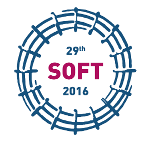Speaker
Marigrazia Moscardini
(Institute for Applied Materials)
Description
Five ITER project members are actively involved in the fabrication of tritium breeding ceramics pebbles. Different fabrication processes developed by these members strongly influence the characteristics of pebbles produced. One of the main characteristics is the sphericity of pebbles. The spherical shape is the one desired; however the manufacture of perfect round particles is not simple. For these pebbles, sphericity is usually different from unity, sometimes it is quite high (i.e. needle type particles) but sometimes the shape is more close to an oblate spheroid. A Discrete Element Method (DEM) code has been previously developed in the Institute of Applied Materials (IAM) in order to simulate the mechanical behavior of a fusion pebble bed, where pebbles were simulated by perfectly spherical particles. In order to simulate the mechanical behavior of ellipsoidal particles an extension of the previous DEM code was necessary. The method taken into account to represent non spherical particles was the multi-sphere (MS) approach. It is a multi-particles approach based on the union of several spheres to obtain the required shape. The MS method leaves the possibility to continue to use the same algorithms developed for spherical particles. Recently, further improvements have been brought to guarantee the versatility of the code. The code was generalized to allow the user to choose the number and the radius of spherical particles that compose the ellipsoids. Sensitivity studies, mainly related to the variation of the aspect ratio and the radius of spheres, were performed in order to guarantee the applicability of the code for different kinds of pebble assemblies. The aim in the future is to extend the algorithm to even more generalized particle shapes.
Co-authors
Marc Kamlah
(Institute for Applied Materials, Karlsruhe Institute of Technology, Hermann-von-Helmholtz-Platz 1 Eggenstein-Leopoldshafen, Germany)
Marigrazia Moscardini
(Institute for Applied Materials, Karlsruhe Institute of Technology, Hermann-von-Helmholtz-Platz 1 Eggenstein-Leopoldshafen, Germany)
Yixiang Gan
(School of Civil Engineering, University of Sydney, Shepherd Street Sydney NSW 2006, Australia)

